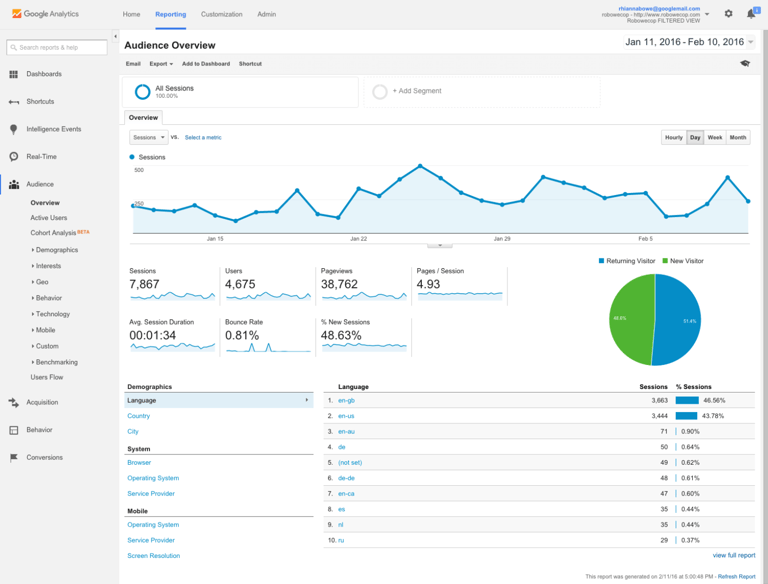In today's competitive business landscape, there is a growing recognition and enthusiasm for the effectiveness of inbound marketing strategies and the impact of inbound marketing efforts. Digital marketing, encompassing various online channels and tactics, plays a pivotal role in driving successful inbound marketing campaigns and achieving business objectives.
At the end of last year, HubSpot published its annual “State of Inbound Marketing” report, the latest version of which surveyed nearly 4000 businesses around the world. It found that: “Inbound is the norm rather than the exception, as 3 out of 4 marketers across the globe prioritize an inbound approach to marketing.”
The short version of answering “why all the fuss?” is simple. It’s because inbound marketing produces greater return on investment than any other form of marketing. In fact, Hubspot found that companies are 3x as likely to see a greater ROI on inbound marketing campaigns than on outbound.
But, there are more questions at hand, not least of all, why does it produce such a big ROI? And what’s really happening in your market right now to make that happen?
True, there are new software-as-a-service (SaaS) products, analytics tools, and a few other components that have contributed to the rise of a successful inbound marketing strategy. The utilisation of an effective inbound marketing strategy, along with marketing automation, has revolutionised the way businesses engage with their target audience and achieve remarkable results.
But before we look at what those are and why they’re important to your business, we must first touch on another subject to answer these questions.
And, perhaps inevitably, the answers lie in a shift in your customer’s buying habits.
Check out the following blogs for more information on inbound marketing services:
- Top 10 reasons to work with an inbound marketing agency
- Marketing Agency for Tech Startups
- 6 Important Reasons You Need an Inbound Marketing Specialist
- Build your Inbound Marketing Strategy
The "secrets" accessed by inbound marketing
In a thesis written for a class taught at Stanford University, PayPal co-founder and investor in multiple billion-dollar valuation companies (including LinkedIn and Facebook) Peter Thiel discusses an idea.
The emphasis is placed on discovering secrets that business ideas can be based on. Secrets that are not too simple (such as gossip), but not too complicated either (such as superstring theory in physics). As Theil puts it:
“Silly and esoteric secrets don’t matter much. And small secrets are of small importance. The focus should be on the secrets that matter: the big secrets that are true.” Peter Thiel, Paypal Co-Founder
When Thiel and his peers created their multibillion dollar ventures, they did so by leveraging this idea. The market wanted a way to simplify social interactions on the web (LinkedIn and Facebook) and to simplify and secure the process of online payments (PayPal).
When there’s something that people are thinking that they’re not telling you, there’s an opportunity to be had. Often times, it’s a big one.
This is what happened with inbound marketing and the services that facilitate it. It was a combination of several secrets combined, that contributed to the creation of the many products, websites and businesses that allow this global marketing machine to exist today.

People have wised up to the "hard sell"
After several decades of salespeople pursuing leads more often with reckless abandon than the charismatic finesse required, customers have become sick of the hard sell.
As CopyBlogger regular, Jon Morrow, puts it in this article titled 6 Ways to Sell Without Selling Your Soul:
“The truth is, the heavy-handed sales’ tactics of the past are no longer appropriate for most businesses. Not only are they morally repugnant, but they’re increasingly ineffective.” Jon Morrow, Copy Blogger
During the time before Google, it was more difficult for people to seek out competitive options for various products and services. But these days, the slick salesperson of old can be bypassed entirely. CEB Global reported that buyers go through 57% of the purchasing process before ever contacting sales.
What are they doing prior to that call? They’re studiously researching their options on well-placed, informative content.
People can make informed decisions on unbiased and commission-free info in a matter of a few keystrokes. We can look at feedback on Yell, product reviews on Amazon, speak to people on social media and other strategies that unequivocally cut through sales’ spiel like a hot knife.
What must you do to attract your customer’s attention?
You must help them. No strings attached, straight-up delivering value that makes a difference. That is the new sales model and that is a key “secret” that’s well-serviced by both the inbound marketing industry and those who capitalise upon it.
Incidentally, Thiel also states in his Stanford class that:
“Salespeople do best when people do not know they’re dealing with salespeople.”
And this concept, can be found at the very centre of inbound marketing.
Inbound marketing means analytics
The term “big data” is an overused buzzword. And, tedious though its continual repetition may be, it does have a grain of truth at the centre. Big data is here, and it is relevant to our discussion.
As Google Analytics continues to evolve into an ever-more complex system, the amount of information you can gather on your potential customers these days is seemingly infinite.

“Big Data is at the foundation of all the megatrends that are happening today, from social media, to mobile, to cloud, to gaming.” Chris Lynch, ex-Vertica Systems CEO
Servicing your potential customers with the kind of reciprocation-inducing value that they expect today and plugging marketing assets into a cloud-based inbound marketing platform (such as HubSpot) means you can gather an enormous amount of valuable, actionable data.
If you can do that, you can not only use it to A/B test and improve current conversions, but know what works to produce more conversions in the future. You can build buyer personas and start creating content specifically targeted towards your best potential customers.
Inbound is the key to social media marketing
At the advent of social media, the term “social media marketing” wasn’t far behind. Businesses all over the world flocked to social platforms excited to see the new, untapped source of millions clients.
Sadly, it didn’t happen.
Not only that, but it quickly became apparent that creating a quantifiable lead generation strategy with a knowledgeable social media manager was incredibly tricky at best.
The missing piece of the puzzle was, of course, great content. Creating great content, whether it was infographics, videos or blog posts, gave people a reason to pay attention and to share on social media, thus unlocking the potential marketing power therein.
There’s more to inbound marketing than just content and social media, but each is an important piece of the puzzle.
Passive lead generation
Inbound marketing comes with a steep learning curve. You need top-level professional writers, search engine optimisers, conversion rate optimisers, social media managers, excellent designers and sometimes more besides.
Putting together a comprehensive strategy is a big job and herein lies another one of Theil’s “secrets”.
Here are five Go To Market Strategy Examples.
Around 60% of businesses outsource inbound marketing services because they can pay a team of rockstar professionals to do the business, sit back and watch the leads come in. It’s a mammoth and very specialised task.
But…
Once these facets combine in a cohesive inbound strategy, sales funnels can be put in place to work magic while inbound marketers continue to build more and more funnels.
Investing money in a quality, properly search-optimised blog post is an asset that can sit in the search engines for months or even years, producing hundreds or even thousands of visitors, each of which is a potential lead.
If you were to spend that same revenue on cold calling, well, you know what happens.
The numbers never lie
The reason why persistent blogging works so well, akin to compound interest, is because it operates in a similar manner. In the beginning, returns may be slightly slower than desired. However, over time, as you establish a strong position in the search engines and are recognized as a "thought leader" in your sector, the returns become enormous. This is where the involvement of inbound marketing companies and inbound marketing focuses can further amplify the benefits.
Marketing spend becomes marketing investment.
This principle is illustrated perfectly by venture capitalists, Tom Tunguz in his blog post on the subject. As Tunguz states:
“Maintaining a drumbeat of content creation requires discipline and persistence. But the compounding benefits of creating this library can drive sustained growth and awareness of your product, brand and company.”
The HubSpot annual report found this to be the case, too.
More numbers can be found from market research organisations such as eMarketer, Forrester and Nielsen Norman Group, all of which continue to conduct and publish great research on all kinds of products and services, inbound marketing included.
Consequently, many statistics about how your potential customers view inbound marketing trickle their way onto the internet, offering more proof of the value of inbound marketing.
Examples include:
- Inbound marketing delivers 54% more leads into the marketing funnel than traditional outbound marketing – Hubspot State of Inbound Report
- Inbound marketing tactics save an average of 13% in overall cost per lead – Hubspot State of Inbound Report
- The biggest reasons professionals access LinkedIn content is to “discover new ideas within the industry,” and “keep up with industry news” at 73% and 78% respectively – Linked In Professional Content Consumption Report 2014
- 70% of consumers say content marketing makes them feel closer to the sponsoring company – Content Marketing Institute
Inbound marketing works and now you know the reason why.
It’s a shift in marketing dynamic that directly addresses a change in behaviour that stands true in both B2C and B2B markets.
It grew company by company, product by service into an entire industry that was hinged on uncovering these secrets. And the sheer effectiveness of the strategy spread via word-of-mouth and good old-fashioned hard data to quickly grow into what it’s become today.
The future for inbound marketing and staying ahead of the curve lies in effectively optimizing every asset in your inbound strategy to maximize your return on marketing investment. This includes the involvement of inbound marketing agencies to generate leads and target the appropriate audience.
Inbound marketing services are the future. Don’t get left behind. We are an inbound marketing agency in London, get in touch with us to find out how we can help.








